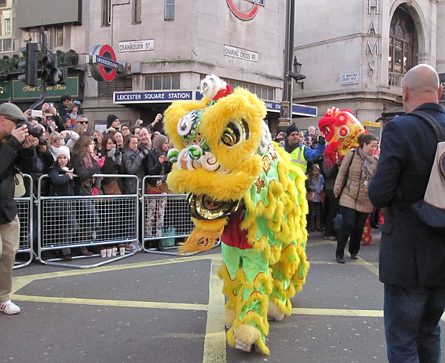
Lion dances are now being made accessible to blind and vision impaired people through audio description. Hong Kong-based Dawning Leung is a world expert on audio description of Lion Dances. She recently presented on the art and challenges of describing lion dances at the Media for All Conference in Sydney. Media Access Australia followed up with Dawning in an extensive interview to discover more about providing access to this very popular Chinese performance.
One of the challenges in describing a lion dance is that you are always trying to balance between the level knowledge in the audience and explaining what is happening visually. How do you assess the right level?
Dawning: Other than being an audio describer, I am also a volunteer helping the vision impaired (VI) in various activities and events, and a guide runner. I have spent some time with them and identified their needs.
There are two types of VI people: those who are born blind and those who become VI. The former ones do not have a chance to watch lion dances. Even if they do, usually no one will explain to them what is happening. In a Spring Dinner of the Hong Kong Society for the Blind in the Chinese New Year (Feb 2015), after I audio described the lion dance performance, one of the blind staff members told me that, in the past, she had no idea what was going on when there was a lion dance, but that night she could learn more about it. For example, she never knew that the lion would bow to the audience at the beginning and the end of the performance.
What do you focus on in the description?
To cater for both groups, I try to be more specific when giving my description. In this case, not only am I providing them with a description service, I am also offering public education about the lion dance to the vision impaired people. Anyhow, the lion dance is one of the most popular Chinese traditions in the world. Everyone should have a chance to learn more about it.
Is there any difference in the way that you would describe a lion dance in a street performance as opposed to in a theatre or other indoor setting?
I think there is one major difference. Lion dance performances in a restaurant/ballroom are different from those performed in the street. The indoor ones have a set routine, and the climax (Cantonese: “choi cheng”/Putonghua (Standard Chinese): “cai qing” which means “pluck the greens/lettuce”) is a must. The lion dancers have to rehearse because of the limited space provided. Conversely, the latter can perform freely in the street; there may not be any choi cheng. The pace of the performance is somehow more slow, and it there is usually more space, for example in a parade.
Describing something live is very different to describing a pre-recorded television show or a film. How do you prepare for a live description?
- Try to familiarise myself with the kind of performance I'm going to audio describe
- Make notes of some keywords regarding movements and actions
How does the audience actually hear the description?
In Hong Kong, when audio describing a live performance in a building, we (the audio describer) would use a microphone and our voice would come out from loud speakers, given that the whole venue is booked for private use only. If the live performance is in open area, we would use headsets.
When you are open-describing a performance (that is where everyone can hear the description) do you do some announcement beforehand explaining what you are going to do or do you just launch into it?
Before my description proper, I normally give an audio introduction to provide information that is essential about the performance/programme, and that is quite impossible to say during the performance/programme due to time restriction.
Who pays for the description?
In Hong Kong, the development of audio description is in its infancy. Many services are done by volunteers. I did audio description for the lion dance in the Spring Dinner that I talked about before voluntarily in February 2015. I was invited as a VIP to the event and was requested to perform audio description for public education. In other cases, if any event organiser wants to provide an audio description service, the organiser may have to pay for it.
How long does it take you to prepare a description for a lion dance?
Bearing in mind that a lion dance lasts for around 10-20 minutes, the preparation stages and times are:
- It takes around two to three hours to watch and record the lion dance rehearsal.
- Around 10-12 hours to conduct research and write the AD script (main focus on the audio introduction and some keywords for the description)
- A few more hours to rehearse. That is, using the keywords in context
Are there any general principles that you have learned from doing lion dances that you could share with others?
The approach is more or less the same for whatever kind of description that you are doing. You need to research background information, watch a rehearsal/run through, write a script and then rehearse.
You may also like:
- Our audio description in the arts page, providing information on accessible museums, galleries, theatre and music.
- Media Access Australia's Cinema & Arts section, covering access to cinema, how to find accessible movies, technologies in development and more.
- Information on assistive technology (AT), explaining the use of screen readers and screen magnifiers for people who are blind or vision impaired.
- Audio description (AD) on TV, covering levels of AD, how it is delivered and the future of audio description in Australia.
- The ADonTV campaign website, outlining progress and development towards getting audio description on Australian TV.
Top of page

